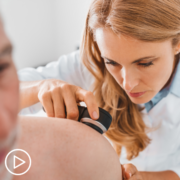How Do Non-Melanoma Skin Cancers Impact Non-White Populations?
How Do Non-Melanoma Skin Cancers Impact Non-White Populations? from Patient Empowerment Network on Vimeo.
Do non-melanoma skin cancers occur differently in non-white populations? Expert Dr. Silvina Pugliese explains how the appearance and location of squamous cell cancer and basal cell cancer can vary in non-white patients.
Silvina Pugliese, M.D., is a Clinical Assistant Professor of Dermatology and Attending Physician at the Stanford Medicine Outpatient Center and Stanford Cancer Institute. Learn more about Dr. Pugliese.
[ACT]IVATION TIP
“…recognize the disparate presentations of non-melanoma skin cancers in patients who are not white. So this includes pigmented basal cell cancers. So looking out not just for shiny red bumps, but also blue or purple bumps on the skin, making sure that patients know and also doctors know how to look within areas of wounds, chronic non-healing wounds and also scars and in different locations such as just…such as the genital skin and the perianal skin, as well as the lower legs where we might see squamous cell cancer in skin of color patients.”
Download Guide | Download Guide en español
See More from [ACT]IVATED Non-Melanoma Skin Cancer
Related Resources:

|

Occupational Exposures and Non-Melanoma Skin Cancer | Understanding Risk Factors |

|
Transcript:
Mary Leer:
In more recent years, the incidence of cutaneous squamous cell carcinoma is increasing not only in non-Hispanic whites, but also in Hispanics and Asians. What are we learning about how non-melanoma skin cancers impact non-white populations?
Dr. Silvina Pugliese:
In dermatology, we’re certainly making a more concerted effort in recent years in studying squamous cell carcinoma in patients of all skin types. Most of our studies in the past were in white patients or lighter skin patients, but in recent years we’ve realized how important it’s to make sure that we know how non-melanoma skin cancers impact all patients, including our skin of color patients.
A few examples of how squamous cell cancer may impact non-white populations differently include where these skin cancers present. So, for example, squamous cell cancers may present in different locations on the body. So when we think about common squamous cell cancer locations, we think about areas exposed to a lot of UV, tops of the ears, the nose, et cetera.
We know that in skin of color patients we might see more of these skin cancers on the lower legs or on the feet or in genital or perianal skin. And that’s important, because we as dermatologists need to make sure that we’re examining all of these areas when we’re doing a full body skin exam.
In addition, about 20 to 40 percent of all squamous cell cancers diagnosed in Black patients are occurring within scars or areas of chronic inflammation such as wounds. It’s, therefore, really important for us to educate patients on the fact that these are areas that could be problematic in the future and need to be evaluated.
Other ways that squamous cell cancer impacts non-white populations is that patients may present…skin of color patients may present with more aggressive disease. There was one study looking at Mohs defect sizes, meaning when surgical procedures are done to remove a skin cancer, what’s left behind after skin cancer is moved is called the defect.
And because some of these skin cancers are more advanced, some of these squamous cell cancers, for example, are more advanced, they will have a larger area of skin removed, which as you can imagine really does impact how the skin heals the risk of scarring, the risk of having any longer term complications from that procedure.
There are a number of things that we can do better on the dermatology side in terms of educating patients about what to look for on their skin and also things that we can do about educating each other. And I’m talking about medical school and residency education in identifying skin cancer in skin of color patients.
Another thing I did want to mention is that basal cell cancer, which is our most common type of skin cancer, has a very different look in patients with skin of color. So it might have more of a purple or blue appearance than the classic pink shiny bump that we talk about. And then finally there is a rare tumor that we call DFSP that is actually more likely to occur in Black patients and can often have a scar-like appearance. This is a rare soft tissue tumor that can involve the deeper skin sometimes into the fat and even muscle.
And patients with skin of color are more likely to present with larger tumors. So my activation tip for this question is to recognize the disparate presentations of non-melanoma skin cancers in patients who are not white. So this includes pigmented basal cell cancers.
So looking out not just for shiny red bumps, but also blue or purple bumps on the skin, making sure that patients know and also doctors know how to look within areas of wounds, chronic non-healing wounds and also scars and in different locations such as just…such as the genital skin and the perianal skin, as well as the lower legs where we might see squamous cell cancer in skin of color patients. So overall I think education all around for our doctors and our patients will help our skin of color patients have their skin cancers, their non-melanoma skin cancers diagnosed more properly.
Share Your Feedback:
Create your own user feedback survey






